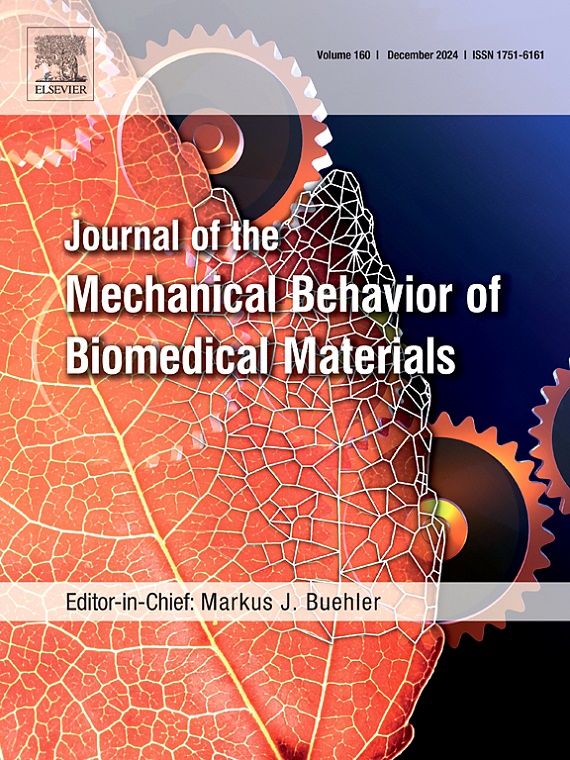Puncturing soft substrates with microneedle Arrays: Experiments, simulations, and machine learning predictions
IF 3.3
2区 医学
Q2 ENGINEERING, BIOMEDICAL
Journal of the Mechanical Behavior of Biomedical Materials
Pub Date : 2025-07-02
DOI:10.1016/j.jmbbm.2025.107112
引用次数: 0
Abstract
Microneedle arrays are innovative medical devices used for drug delivery, tissue adhesion, and neural signal detection. Understanding how their geometric features influence puncture performance in soft substrates is crucial for optimal design. This study first investigates the effects of shaft diameter and tip angle of a single microneedle through puncture experiments, revealing that reducing these parameters decreases the critical puncture force and depth. Subsequently, the puncture of three types of microneedle arrays: planar, “arrow-shaped”, and “wave-shaped”, are investigated via experiments and simulations. Key geometric factors, including height difference, spacing, tip angle, and diameter of microneedles within each microneedle array, are analyzed for their impact on the peak puncture force and the puncture efficiency. Results indicate that the height variation significantly affects the peak puncture force of “wave-shaped” arrays, while increased spacing enhances the puncture efficiency and the peak puncture force across all designs. Though larger tip angles reduce the puncture efficiency, this effect is mitigated in “array-shaped” and “wave-shaped” arrays. Smaller diameters lower the peak puncture force and improve the puncture efficiency in all cases. Furthermore, 152 simulation results are utilized to train an artificial neural network (ANN), which successfully predicts the puncture force at a specified depth for a microneedle array when the geometric parameters of the array are provided. This study provides insights into the combined effects of microneedle array geometries on puncture performance, guiding the design of more effective microneedle systems.
用微针阵列刺穿软基板:实验,模拟和机器学习预测
微针阵列是一种创新的医疗设备,用于药物输送、组织粘附和神经信号检测。了解它们的几何特征如何影响软基板的穿刺性能对于优化设计至关重要。本研究首先通过穿刺实验考察了单根微针的轴径和针尖角对穿刺的影响,发现减小这些参数会降低临界穿刺力和穿刺深度。随后,通过实验和模拟研究了平面、“箭头”和“波浪”三种微针阵列的穿刺。分析了各微针阵列内微针的高度差、间距、针尖角和直径等关键几何因素对峰值穿刺力和穿刺效率的影响。结果表明:高度变化显著影响“波浪形”阵列的峰值穿刺力,而增加间距可提高所有设计的穿刺效率和峰值穿刺力。虽然较大的尖端角度会降低穿刺效率,但这种影响在“阵列”和“波浪”阵列中得到缓解。在所有情况下,较小的直径降低了峰值穿刺力,提高了穿刺效率。利用152个仿真结果训练人工神经网络(ANN),在给定微针阵列几何参数的情况下,成功预测了微针阵列在指定深度处的穿刺力。该研究提供了微针阵列几何形状对穿刺性能的综合影响,指导了更有效的微针系统的设计。
本文章由计算机程序翻译,如有差异,请以英文原文为准。
求助全文
约1分钟内获得全文
求助全文
来源期刊

Journal of the Mechanical Behavior of Biomedical Materials
工程技术-材料科学:生物材料
CiteScore
7.20
自引率
7.70%
发文量
505
审稿时长
46 days
期刊介绍:
The Journal of the Mechanical Behavior of Biomedical Materials is concerned with the mechanical deformation, damage and failure under applied forces, of biological material (at the tissue, cellular and molecular levels) and of biomaterials, i.e. those materials which are designed to mimic or replace biological materials.
The primary focus of the journal is the synthesis of materials science, biology, and medical and dental science. Reports of fundamental scientific investigations are welcome, as are articles concerned with the practical application of materials in medical devices. Both experimental and theoretical work is of interest; theoretical papers will normally include comparison of predictions with experimental data, though we recognize that this may not always be appropriate. The journal also publishes technical notes concerned with emerging experimental or theoretical techniques, letters to the editor and, by invitation, review articles and papers describing existing techniques for the benefit of an interdisciplinary readership.
 求助内容:
求助内容: 应助结果提醒方式:
应助结果提醒方式:


